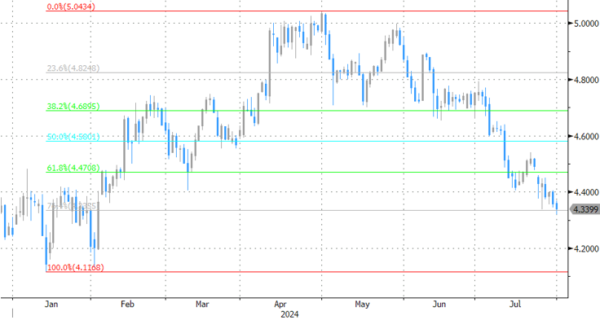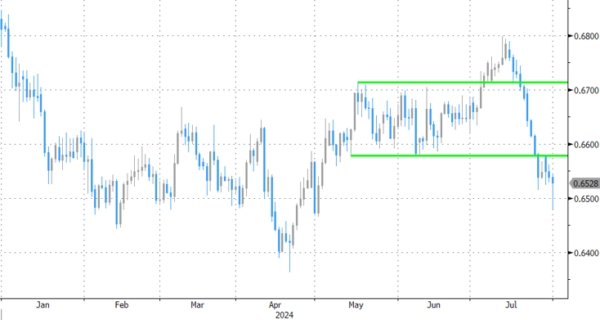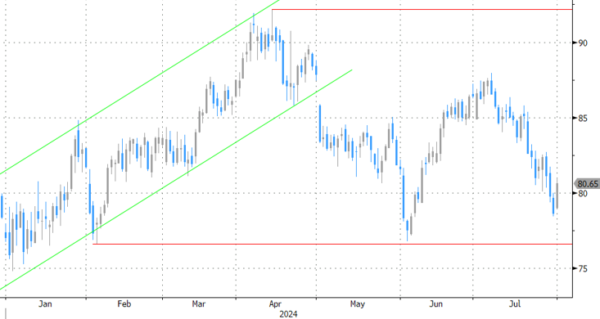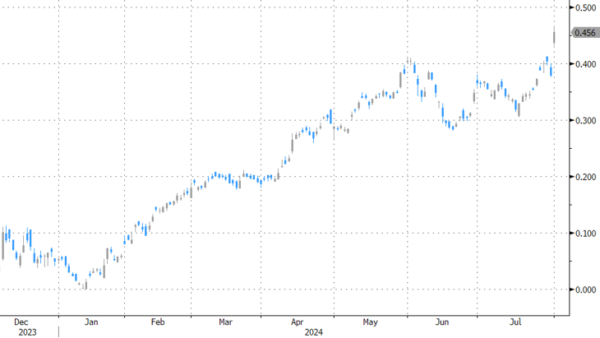Markets
The biggest moves in markets ahead of tonight’s Fed policy meeting happened in the Japanese yen. A not completely expected rate hike to 0.25% by the Bank of Japan this morning, accompanied by a bond taper programme, took some investors off guard. In a hawkish presser afterwards, governor Ueda said that if the economy evolves according to the outlook, more rate hikes will follow, possibly beyond neutral (+/-0.5%). Ueda added that the weak currency was an argument to raise the rate today, along with increased confidence of a consumer-driven sustained return to the 2% inflation target. USD/JPY is testing the 150 barrier, the lowest level since mid-March on JPY strength (rather than USD-weakness that drove much of the recent USD/JPY decline). European markets eyeballed the EMU inflation print. Prices in July evolved in a not so comfortable way for the ECB. The headline figure was flat m/m, allowing the y/y figure to unexpectedly pick up from 2.5% to 2.6%. Core inflation stood at a June-matching 2.9%, defying expectations for a minor deceleration. And services inflation, lastly, barely eased from the 4.1% in June to 4% this month – a level deemed too high to reconcile with the ECB’s overall 2% target. An attempt of European/German yields to reverse earlier declines quickly faded to nothing and returned towards intraday lows. Net daily changes vary between 3.2-3.8 bps. The euro did hold on to some minor gains against the dollar (EUR/USD around 1.084) as the former was weighed down by a drop in US yields as well (2-4 bps)-. Q2 Employment Cost Index – the Fed’s preferred wage measure – came in a tad below consensus, ie 0.9% vs 1% (4.1% y/y, the slowest advance since 2021). Both wages & salaries (the base compensation component) as well as benefits eased compared to the previous quarter, suggesting moderating wage growth in a ditto labour market. The latter was also confirmed by the ADP job report printing at sub-par 122k.
We are now headed towards tonight’s FOMC meeting. The Fed’s status quo at 5.25-5.5% is widely anticipated. The central question is whether the recent string of beneficial CPI outcomes and mostly below-consensus economic outcomes will prompt clearer clues towards a first cut (in September) in either the statement or the presser. We think there’s a possibility of that to happen, be it subtle in order to prevent the recent sharp yield correction go much further against the background of thinner liquidity circumstances and technical support zones at the verge of breaking. Complementing the case for (short-term) yields not to drop much lower from current levels is the current pricing in money markets (almost three cuts priced in for 2024). The four cuts for 2025, as things currently stand, seem appropriate as well. First support for the dollar kicks in at EUR/USD 1.09. That should hold.
News & Views
Polish inflation in July came in to the soft side of expectations. While the monthly reading quickened sharply from 0.1% to 1.4%, it fell short of a 1.6% consensus estimate. On a yearly basis, the number picked up from 2.6% to a 2024 high of 4.2%. That undershot expectations by 0.2 ppts but is nevertheless well above the central bank’s 2.5% +/- 1 ppt target. The few details made available by Poland Statistics showed that electricity, gas and other utilities drove the dramatic increase (+11.8% m/m). This was the result of the government’s decision to raise the energy cap for the second half of 2024. This will affect all upcoming readings on a similar basis and is one of the reasons for the hawkish monetary policy stance. The majority of the MPC council agrees that no cuts are appropriate this year with governor Glapinski at some point ruling out 2025 as well. Council member Wnorowski in a first reaction after the release said that inflation at the beginning of next year could pick up further but said he sees reasons for discussions about cuts to start in 2025Q2. The Polish zloty trades little chanced around EUR/PLN 4.29.
Following up on the US Treasury announcing the updated borrowing estimates for the running (and upcoming) quarter, the agency today released quarterly refunding statement detailing the borrowing strategy. The US Treasury expects that, based on current projected borrowing needs, it does not have to increase auction sizes for at least the next several quarters. With the exception of the August refinancing round (temporary $3 bn uptick in the 7-yr, 10-yr and 30-yr auction size), all other auction sizes were left unchanged at least through October 2024. That means the financing strategy remains tilted towards short(er) maturities with monthly sizes ranging from $58 to $70bn.
Graphs
US 2-yr yield reaches make or break moment
AUD/USD: Aussie dollar erases much of the CPI-driven weakness as US counterpart remains unconvincing
Brent ($/b) snaps losing streak as geopolitical concerns flare up (Israeli retaliatory attack in Lebanon)
Japanese 2-yr yield shoots to highest level in 15 years as central bank hiked and flags more to come, conditional on eco developments
















